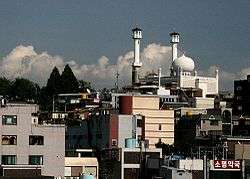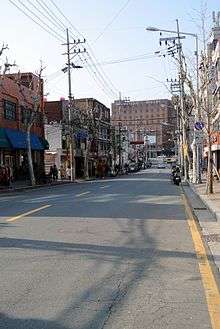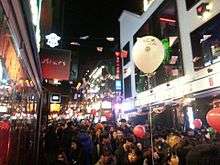Itaewon
Itaewon (Korean: 이태원, IPA [itʰɛwʌn]) refers to an area surrounding Itaewon-dong, Yongsan-gu, Seoul, South Korea. It is served by Seoul Subway Line 6 via Itaewon, Noksapyeong and Hanganjin stations. About 22,000 people reside in the district and it is a popular area for residents of Seoul, tourists, expats and U.S. military personnel.[1] It is known as Seoul's International District and is the home of many foreigners in South Korea.
Itaewon | |
|---|---|
| Korean transcription(s) | |
| • Hangul | 이태원 |
| • Hanja | 梨泰院 |
| • Revised Romanization | Itaewon |
| • McCune–Reischauer | It'aewŏn |
 Itaewon featuring Seoul Central Mosque | |
 Itaewon | |
| Coordinates: 37°32′N 126°59′E | |
| Country | South Korea |
Etymology
The word Itaewon derived from the name of a government-run inn in the Chosun dynasty. Nowadays the area is known as Itaewon because of its abundant pear trees, the Chinese character 梨 meaning "pear." According to ancient records, the area was also written using other hanja transcriptions, such as 李泰院, and 異胎院.
Local attractions
As Seoul's International District, Itaewon is known for serving cuisine that are not widely available in Korea, such as those from Britain, Germany, France, India, Italy, Southeast Asia, Portugal, Spain, Turkey, Mexico, America, and Canada. Essentially, it is known as the "International District", or sometimes as "Western Town," reminiscent of many Chinatowns in Western nations.
Itaewon, along with neighborhoods and attractions like Hongdae, Insadong, and Seoul Tower, is one of the most popular places in Seoul for tourists.[2] Major hotels such as the Grand Hyatt Seoul and local landmark Hamilton Hotel are here, as well as several smaller hotels and guesthouses. Dozens of shops are aimed at tourists, and offer Western or traditional Korean souvenirs. High-quality leather products, retail or custom made, and are sold at reasonable prices (though haggling is expected) as well.
Itaewon was long known as a hub for high quality counterfeit goods, but those products have largely disappeared.[3] Some authentic goods that are only produced in Korea for the international market, as well as some authentic imports are also available. Itaewon is known for its clothes makers who produce custom-made shirts and suits.
Itaewon includes the area known as Homo Hill and is Seoul's Gay village.[4] Despite the taboo nature of homosexuality in South Korea, people can express themselves openly within the neighborhood.[5]
 A street in Itaewon
A street in Itaewon Bogwang street and Hamilton Hotel in Itaewon
Bogwang street and Hamilton Hotel in Itaewon
Many foreigners in Korea reside within or near Itaewon, as well as some of the richest Korean business-people, including Lee Kun-Hee, the chairman of Samsung group.
Gyeongnidan Street
In Itaewon there is the multinational Gyeongnidan Street. It is in the middle of Itaewon's elementary school district. There are many exotic restaurants alongside the street.[6]
Festival
- Global village festival
- Halloween festival


In popular culture
Korean singer-songwriter JYP (Park Jin-young) and Yoo Se-yoon's hip hop duo UV released the song "Itaewon Freedom" in April 2011.[7] The title alludes to (and the lyrics celebrate) a common Korean perception of Itaewon's foreignness and open atmosphere, in contrast with conventional Korean culture, which is more conservative.[8] The popularity of the song and its music video inspired a parody cover song and video from the girl group Crayon Pop in 2013. Both videos were partially filmed on location in Itaewon.[9]
The 2020 South Korean television series Itaewon Class is set in Itaewon.[10]
Revitalization Post 9/11
Itaewon is the commercial district closest to the Yongsan Garrison of the United States Forces Korea (USFK). In 2001, Itaewon was most known for the seedy bars and prostitution parlors that catered to the foreign soldiers and servicemen based in Yongsan. After 9/11, all military bases were put on lockdown with strict curfews imposed. As a result, many of the bars closed down. Coffee shops, trendy bars, and fusion and international fare restaurants opened in their places, turning Itaewon into a popular district for young, worldly Koreans and foreign residents. It now hosts an annual Itaewon Global Village Festival, cementing its reputation as an exotic, multi-cultural Gangnam.[11]
Transportation
- Itaewon Station - Seoul Subway Line 6
See also
- Haebangchon
- List of Korea-related topics
- Yongsan-gu
- Yongsan Garrison
Notes
- Lai, Ah Eng; Collins, Francis Leo; Yeoh, Brenda S. A. (2013). Migration and Diversity in Asian Contexts. ISBN 9789814380478.
- Government, Seoul Metropolitan (2010-02-02). "Seoul's best 100".
- Kim, Monica. "Listen to Monica Kim Discuss How Korea's Counterfeit Culture Shaped Her Style". Vogue. Retrieved 2019-03-12.
- "Itaewon". The Seoul Guide. Retrieved 11 May 2020.
- "Gay Seoul". Gay Travel. Retrieved 11 May 2020.
- Government, Seoul Metropolitan (2014-09-18). "Soul food of Seoul: Seoul Dining, A DELICIOUS EPICUREAN JOURNEY".
- "[New Releases] UV". Korea JoongAng Daily.
- Kim, Chan-hee (2011). "The Cultural Identity of Itaewon" (PDF). Yonsei University. Retrieved 3 October 2018.
- "Crayon Pop takes to the streets for parody MV of 'Itaewon Freedom'".
- Choi, Ji-won (January 30, 2020). "Park Seo-joon to show perfect sync with original webcomic in 'Itaewon Class'". The Korea Herald. Retrieved February 7, 2020.
- "Seoul's Red-Light District Turns Trendy" – via www.wsj.com.
